599 scholarly books by Russell Sage Foundation and 23
start with B
599 scholarly books by Russell Sage Foundation and 23
599 scholarly books by Russell Sage Foundation
23 start with B start with B
23 start with B start with B
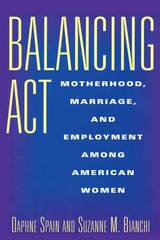
Balancing Act
Motherhood, Marriage, and Employment Among American Women
Daphne Spain
Russell Sage Foundation, 1996
"A wonderful compendium of everything you always wanted to know about trends in women's roles—both in and out of the home. It is a balanced and data-rich assessment of how far women have come and how far they still have to go. "—Isabelle Sawhill, Urban Institute "Based primarily on the 1990 population census, Balancing Act reports on the current situation of American women and temporal and cross-national comparisons. Meticulously and clearly presented, the information in this book highlights changing behaviors, such as the growing incidence of childbearing to older women, and unmarried women in general, and a higher ratio of women's earnings to men's. The authors' thoughtful analysis of these and other factors involved in women's fin de siècle 'balancing act' make this an indispensable reference book and valuable classroom resource." —Louise A. Tilly, Michael E. Gellert Professor of History and Sociology, The New School for Social Research In Balancing Act, authors Daphne Spain and Suzanne Bianchi draw upon multiple census and survey sources to detail the shifting conditions under which women manage their roles as mothers, wives, and breadwinners. They chronicle the progress made in education—where female college enrollment now exceeds that of males—and the workforce, where women have entered a wider variety of occupations and are staying on the job longer, even after becoming wives and mothers. But despite progress, lower-paying service and clerical positions remain predominantly female, and although the salary gap between men and women has shrunk, women are still paid less. As women continue to establish a greater presence outside the home, many have delayed marriage and motherhood. Marked jumps in divorce and out-of-wedlock childbirth have given rise to significant numbers of female-headed households. Married women who work contribute more significantly than ever to the financial well-being of their families, yet evidence shows that they continue to perform most household chores. Balancing Act focuses on how American women juggle the simultaneous demands of caregiving and wage earning, and compares their options to those of women in other countries. The United States is the only industrialized nation without policies to support working mothers and their families—most tellingly in the absence of subsidized childcare services. Many women are forced to work in less rewarding part-time or traditionally female jobs that allow easy exit and re-entry, and as a consequence poverty is the single greatest danger facing American women. As the authors show, the risk of poverty varies significantly by race and ethnicity, with African Americans—most of whose children live in mother-only families—the most adversely affected. This volume contributes to the national dialogue about family policy, welfare reform, and responsibility for children by highlighting the pivotal roles women play at the intersection of family and work.
[more]
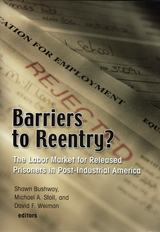
Barriers to Reentry?
The Labor Market for Released Prisoners in Post-Industrial America
Shawn D. Bushway
Russell Sage Foundation, 2007
With the introduction of more aggressive policing, prosecution, and sentencing since the late 1970s, the number of Americans in prison has increased dramatically. While many have credited these "get tough" policies with lowering violent crime rates, we are only just beginning to understand the broader costs of mass incarceration. In Barriers to Reentry? experts on labor markets and the criminal justice system investigate how imprisonment affects ex-offenders' employment prospects, and how the challenge of finding work after prison affects the likelihood that they will break the law again and return to prison. The authors examine the intersection of imprisonment and employment from many vantage points, including employer surveys, interviews with former prisoners, and state data on prison employment programs and post-incarceration employment rates. Ex-prisoners face many obstacles to re-entering the job market—from employers' fears of negligent hiring lawsuits to the lost opportunities for acquiring work experience while incarcerated. In a study of former prisoners, Becky Pettit and Christopher Lyons find that employment among this group was actually higher immediately after their release than before they were incarcerated, but that over time their employment rate dropped to their pre-imprisonment levels. Exploring the demand side of the equation, Harry Holzer, Steven Raphael, and Michael Stoll report on their survey of employers in Los Angeles about the hiring of former criminals, in which they find strong evidence of pervasive hiring discrimination against ex-prisoners. Devah Pager finds similar evidence of employer discrimination in an experiment in which Milwaukee employers were presented with applications for otherwise comparable jobseekers, some of whom had criminal records and some of whom did not. Such findings are particularly troubling in light of research by Steven Raphael and David Weiman which shows that ex-criminals are more likely to violate parole if they are unemployed. In a concluding chapter, Bruce Western warns that prison is becoming the norm for too many inner-city minority males; by preventing access to the labor market, mass incarceration is exacerbating inequality. Western argues that, ultimately, the most successful policies are those that keep young men out of prison in the first place. Promoting social justice and reducing recidivism both demand greater efforts to reintegrate former prisoners into the workforce. Barriers to Reentry? cogently underscores one of the major social costs of incarceration, and builds a compelling case for rethinking the way our country rehabilitates criminals.
[more]
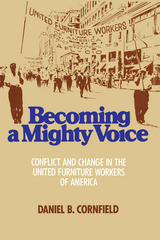
Becoming a Mighty Voice
Daniel Cornfield
Russell Sage Foundation, 1989
American labor unions resemble private representative democracies, complete with formally constituted conventions and officer election procedures. Like other democratic institutions, unions have repeatedly experienced highly charged conflicts over the integration of ethnic minorities and women into leadership positions. In Becoming a Mighty Voice, Daniel B. Cornfield traces the 55-year history of the United Furniture Workers of America (UFWA), describing the emergence of new social groups into union leadership and the conditions that encouraged or inhibited those changes. This vivid case history explores leadership change during eras of union growth, stability, and decline, not simply during isolated episodes of factionalism. Cornfield demonstrates that despite the strong forces perpetuating existing union hierarchies, leadership turnover is just as likely as leadership stagnation. He also shows that factors external to the union may influence leadership change; periods of turnover in the UFWA leadership reflected employer efforts to find cheap, non-union labor, as well as union efforts to unionize workers. When unions are threatened by intensified conflict with employers and when entrenched high status groups within the union are obliged to recruit members of lower socioeconomic status, then new social groups are likely to be integrated into union leadership. Becoming a Mighty Voice develops a theory of leadership change that will be of interest to many engaged in the labor, civil rights, and women's movements as well as to sociologists or historians of work, gender, and race, and to students of political and organizational behavior.
[more]
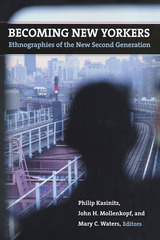
Becoming New Yorkers
Ethnographies of the New Second Generation
Philip Kasinitz
Russell Sage Foundation, 2004
More than half of New Yorkers under the age of eighteen are the children of immigrants. This second generation shares with previous waves of immigrant youth the experience of attempting to reconcile their cultural heritage with American society. In Becoming New Yorkers, noted social scientists Philip Kasinitz, John Mollenkopf, and Mary Waters bring together in-depth ethnographies of some of New York's largest immigrant populations to assess the experience of the new second generation and to explore the ways in which they are changing the fabric of American culture. Becoming New Yorkers looks at the experience of specific immigrant groups, with regard to education, jobs, and community life. Exploring immigrant education, Nancy López shows how teachers' low expectations of Dominican males often translate into lower graduation rates for boys than for girls. In the labor market, Dae Young Kim finds that Koreans, young and old alike, believe the second generation should use the opportunities provided by their parents' small business success to pursue less arduous, more rewarding work than their parents. Analyzing civic life, Amy Forester profiles how the high-ranking members of a predominantly black labor union, who came of age fighting for civil rights in the 1960s, adjust to an increasingly large Caribbean membership that sees the leaders not as pioneers but as the old-guard establishment. In a revealing look at how the second-generation views itself, Sherry Ann Butterfield and Aviva Zeltzer-Zubida point out that black West Indian and Russian Jewish immigrants often must choose whether to identify themselves alongside those with similar skin color or to differentiate themselves from both native blacks and whites based on their unique heritage. Like many other groups studied here, these two groups experience race as a fluid, situational category that matters in some contexts but is irrelevant in others. As immigrants move out of gateway cities and into the rest of the country, America will increasingly look like the multicultural society vividly described in Becoming New Yorkers. This insightful work paints a vibrant picture of the experience of second generation Americans as they adjust to American society and help to shape its future.
[more]
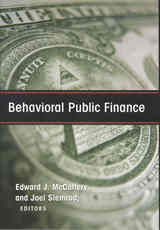
Behavioral Public Finance
Edward J. McCaffery
Russell Sage Foundation, 2006
Behavioral economics questions the basic underpinnings of economic theory, showing that people often do not act consistently in their own self-interest when making economic decisions. While these findings have important theoretical implications, they also provide a new lens for examining public policies, such as taxation, public spending, and the provision of adequate pensions. How can people be encouraged to save adequately for retirement when evidence shows that they tend to spend their money as soon as they can? Would closer monitoring of income tax returns lead to more honest taxpayers or a more distrustful, uncooperative citizenry? Behavioral Public Finance, edited by Edward McCaffery and Joel Slemrod, applies the principles of behavioral economics to government's role in constructing economic and social policies of these kinds and suggests that programs crafted with rational participants in mind may require redesign. Behavioral Public Finance looks at several facets of economic life and asks how behavioral research can increase public welfare. Deborah A. Small, George Loewenstein, and Jeff Strnad note that public support for a tax often depends not only on who bears its burdens, but also on how the tax is framed. For example, people tend to prefer corporate taxes over sales taxes, even though the cost of both is eventually extracted from the consumer. James J. Choi, David Laibson, Brigitte C. Madrian, and Andrew Metrick assess the impact of several different features of 401(k) plans on employee savings behavior. They find that when employees are automatically enrolled in a retirement savings plan, they overwhelmingly accept the status quo and continue participating, while employees without automatic enrollment typically take over a year to join the saving plan. Behavioral Public Finance also looks at taxpayer compliance. While the classic economic model suggests that the low rate of IRS audits means far fewer people should voluntarily pay their taxes than actually do, John Cullis, Philip Jones, and Alan Lewis present new research showing that many people do not underreport their incomes even when the probability of getting caught is a mere one percent. Human beings are not always rational, utility-maximizing economic agents. Behavioral economics has shown how human behavior departs from the assumptions made by generations of economists. Now, Behavioral Public Finance brings the insights of behavioral economics to analysis of policies that affect us all.
[more]
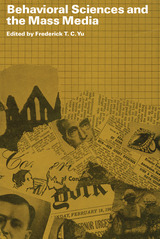
Behavioral Sciences and the Mass Media
Frederick T. C. Yu
Russell Sage Foundation, 1968
Presents papers which were discussed at the Arden House Conference—a conference held to establish a working relationship between sociologists at the Russell Sage Foundation and journalists of the Graduate School of Journalism of Columbia University. Both behavioral science and journalism have for a long time been concerned with some of the same major national social problems—juvenile delinquency, urban problems, race and minority group relations, international tensions, and labor relations. These papers touch on some of the barriers to communication and point to possible ways of breaking through those barriers.
[more]
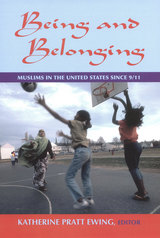
Being and Belonging
Muslims in the United States since 9/11
Katherine Pratt Ewing
Russell Sage Foundation, 2008
The terrorist attacks of September 11, 2001, instantly transformed many ordinary Muslim and Arab Americans into suspected terrorists. In the weeks and months following the attacks, Muslims in the United States faced a frighteningly altered social climate consisting of heightened surveillance, interrogation, and harassment. In the long run, however, the backlash has been more complicated. In Being and Belonging, Katherine Pratt Ewing leads a group of anthropologists, sociologists, and cultural studies experts in exploring how the events of September 11th have affected the quest for belonging and identity among Muslims in America—for better and for worse. From Chicago to Detroit to San Francisco, Being and Belonging takes readers on an extensive tour of Muslim America—inside mosques, through high school hallways, and along inner city streets. Jen'nan Ghazal Read compares the experiences of Arab Muslims and Arab Christians in Houston and finds that the events of 9/11 created a "cultural wedge" dividing Arab Americans along religious lines. While Arab Christians highlighted their religious affiliation as a means of distancing themselves from the perceived terrorist sympathies of Islam, Muslims quickly found that their religious affiliation served as a barrier, rather than a bridge, to social and political integration. Katherine Pratt Ewing and Marguerite Hoyler document the way South Asian Muslim youth in Raleigh, North Carolina, actively contested the prevailing notion that one cannot be both Muslim and American by asserting their religious identities more powerfully than they might have before the terrorist acts, while still identifying themselves as fully American. Sally Howell and Amaney Jamal distinguish between national and local responses to terrorism. In striking contrast to the erosion of civil rights, ethnic profiling, and surveillance set into motion by the federal government, well-established Muslim community leaders in Detroit used their influence in law enforcement, media, and social services to empower the community and protect civil rights. Craig Joseph and Barnaby Riedel analyze how an Islamic private school in Chicago responded to both September 11 and the increasing ethnic diversity of its student body by adopting a secular character education program to instruct children in universal values rather than religious doctrine. In a series of poignant interviews, the school's students articulate a clear understanding that while 9/11 left deep wounds on their community, it also created a valuable opportunity to teach the nation about Islam. The rich ethnographies in this volume link 9/11 and its effects to the experiences of a group that was struggling to be included in the American mainstream long before that fateful day. Many Muslim communities never had a chance to tell their stories after September 11. In Being and Belonging, they get that chance.
[more]
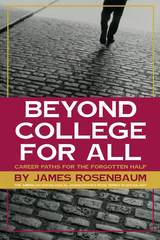
Beyond College For All
Career Paths for the Forgotten Half
James E. Rosenbaum
Russell Sage Foundation, 2001
In a society where everyone is supposed to go to college, the problems facing high school graduates who do not continue their education are often forgotten. Many cannot find jobs, and those who do are often stuck in low-wage, dead-end positions. Meanwhile employers complain that high school graduates lack the necessary skills for today's workplace. Beyond College for All focuses on this crisis in the American labor market. Around the world, author James E. Rosenbaum finds, employers view high school graduates as valuable workers. Why not here? Rosenbaum reports on new studies of the interaction between employers and high schools in the United States. He concludes that each fails to communicate its needs to the other, leading to a predictable array of problems for young people in the years after graduation. High schools caught up in the college-for-all myth, provide little job advice or preparation, leading students to make unrealistic plans and hampering both students who do not go to college and those who start college but do not finish. Employers say they care about academic skills, but then do not consider grades when deciding whom to hire. Faced with few incentives to achieve, many students lapse into precisely the kinds of habits employers deplore, doing as little as possible in high school and developing poor attitudes. Rosenbaum contrasts the situation in the United States with that of two other industrialized nations-Japan and Germany-which have formal systems for aiding young people who are looking for employment. Virtually all Japanese high school graduates obtain work, and in Germany, eighteen-year-olds routinely hold responsible jobs. While the American system lacks such formal linkages, Rosenbaum uncovers an encouraging hidden system that helps many high school graduates find work. He shows that some American teachers, particularly vocational teachers, create informal networks with employers to guide students into the labor market. Enterprising employers have figures out how to use these networks to meet their labor needs, while students themselves can take steps to increase their ability to land desirable jobs. Beyond College for All suggests new policies based on such practices. Rosenbaum presents a compelling case that the problems faced by American high school graduates and employers can be solved if young people, employers, and high schools build upon existing informal networks to create formal paths for students to enter the world of work. A Volume in the American Sociological Association's Rose Series in Sociology
[more]
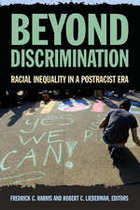
Beyond Discrimination
Racial Inequality in a Post-Racist Era
Fredrick C. Harris
Russell Sage Foundation, 2013
Nearly a half century after the civil rights movement, racial inequality remains a defining feature of American life. Along a wide range of social and economic dimensions, African Americans consistently lag behind whites. This troubling divide has persisted even as many of the obvious barriers to equality, such as state-sanctioned segregation and overt racial hostility, have markedly declined. How then can we explain the stubborn persistence of racial inequality? In Beyond Discrimination: Racial Inequality in a Post-Racist Era, a diverse group of scholars provides a more precise understanding of when and how racial inequality can occur without its most common antecedents, prejudice and discrimination. Beyond Discrimination focuses on the often hidden political, economic and historical mechanisms that now sustain the black-white divide in America. The first set of chapters examines the historical legacies that have shaped contemporary race relations. Desmond King reviews the civil rights movement to pinpoint why racial inequality became an especially salient issue in American politics. He argues that while the civil rights protests led the federal government to enforce certain political rights, such as the right to vote, addressing racial inequities in housing, education, and income never became a national priority. The volume then considers the impact of racial attitudes in American society and institutions. Phillip Goff outlines promising new collaborations between police departments and social scientists that will improve the measurement of racial bias in policing. The book finally focuses on the structural processes that perpetuate racial inequality. Devin Fergus discusses an obscure set of tax and insurance policies that, without being overtly racially drawn, penalizes residents of minority neighborhoods and imposes an economic handicap on poor blacks and Latinos. Naa Oyo Kwate shows how apparently neutral and apolitical market forces concentrate fast food and alcohol advertising in minority urban neighborhoods to the detriment of the health of the community. As it addresses the most pressing arenas of racial inequality, from education and employment to criminal justice and health, Beyond Discrimination exposes the unequal consequences of the ordinary workings of American society. It offers promising pathways for future research on the growing complexity of race relations in the United States.
[more]
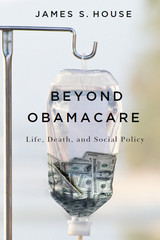
Beyond Obamacare
Life, Death, and Social Policy
James S. House is Angus Campbell Distinguished University Professor Emeritus of Survey Research, Public Policy, and Sociology at the University of Michigan, Ann Arbor.
Russell Sage Foundation, 2015
Health care spending in the United States today is approaching 20 percent of GDP, yet levels of U.S. population health have been declining for decades relative to other wealthy and even some developing nations. How is it possible that the United States, which spends more than any other nation on health care and insurance, now has a population markedly less healthy than those of many other nations? Sociologist and public health expert James S. House analyzes this paradoxical crisis, offering surprising new explanations for how and why the United States has fallen into this trap. In Beyond Obamacare, House shows that health care reforms, including the Affordable Care Act, cannot resolve this crisis because they do not focus on the underlying causes for the nation’s poor health outcomes, which are largely social, economic, environmental, psychological, and behavioral. House demonstrates that the problems of our broken health care and insurance system are interconnected with our large and growing social disparities in education, income, and other conditions of life and work, and calls for a complete reorientation of how we think about health. He concludes that we need to move away from our misguided and almost exclusive focus on biomedical determinants of health, and to place more emphasis on addressing social, economic, and other inequalities. House’s review of the evidence suggests that the landmark Affordable Care Act of 2010, and even universal access to health care, are likely to yield only marginal improvements in population health or in reducing health care expenditures. In order to rein in spending and improve population health, we need to refocus health policy from the supply side—which makes more and presumably better health care available to more citizens—to the demand side—which would improve population health though means other than health care and insurance, thereby reducing need and spending for health care. House shows how policies that provide expanded educational opportunities, more and better jobs and income, reduced racial-ethnic discrimination and segregation, and improved neighborhood quality enhance population health and quality of life as well as help curb health spending. He recommends redirecting funds from inefficient supply-side health care measures toward broader social initiatives focused on education, income support, civil rights, housing and neighborhoods, and other reforms, which can be paid for from savings in expenditures for health care and insurance. A provocative reconceptualization of health in America, Beyond Obamacare looks past partisan debates to show how cost-efficient and effective health policies begin with more comprehensive social policy reforms.
[more]
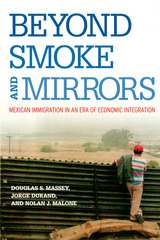
Beyond Smoke and Mirrors
Mexican Immigration in an Era of Economic Integration
Douglas S. Massey
Russell Sage Foundation, 2002
Migration between Mexico and the United States is part of a historical process of increasing North American integration. This process acquired new momentum with the passage of the North American Free Trade Agreement in 1994, which lowered barriers to the movement of goods, capital, services, and information. But rather than include labor in this new regime, the United States continues to resist the integration of the labor markets of the two countries. Instead of easing restrictions on Mexican labor, the United States has militarized its border and adopted restrictive new policies of immigrant disenfranchisement. Beyond Smoke and Mirrors examines the devastating impact of these immigration policies on the social and economic fabric of the Mexico and the United States, and calls for a sweeping reform of the current system. Beyond Smoke and Mirrors shows how U.S. immigration policies enacted between 1986–1996—largely for symbolic domestic political purposes—harm the interests of Mexico, the United States, and the people who migrate between them. The costs have been high. The book documents how the massive expansion of border enforcement has wasted billions of dollars and hundreds of lives, yet has not deterred increasing numbers of undocumented immigrants from heading north. The authors also show how the new policies unleashed a host of unintended consequences: a shift away from seasonal, circular migration toward permanent settlement; the creation of a black market for Mexican labor; the transformation of Mexican immigration from a regional phenomenon into a broad social movement touching every region of the country; and even the lowering of wages for legal U.S. residents. What had been a relatively open and benign labor process before 1986 was transformed into an exploitative underground system of labor coercion, one that lowered wages and working conditions of undocumented migrants, legal immigrants, and American citizens alike. Beyond Smoke and Mirrors offers specific proposals for repairing the damage. Rather than denying the reality of labor migration, the authors recommend regularizing it and working to manage it so as to promote economic development in Mexico, minimize costs and disruptions for the United States, and maximize benefits for all concerned. This book provides an essential "user's manual" for readers seeking a historical, theoretical, and substantive understanding of how U.S. policy on Mexican immigration evolved to its current dysfunctional state, as well as how it might be fixed.
[more]
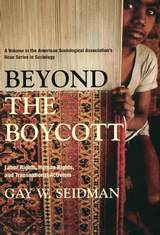
Beyond the Boycott
Labor Rights, Human Rights, and Transnational Activism
Gay W. Seidman
Russell Sage Foundation, 2007
As the world economy becomes increasingly integrated, companies can shift production to wherever wages are lowest and unions weakest. How can workers defend their rights in an era of mobile capital? With national governments forced to compete for foreign investment by rolling back legal protections for workers, fair trade advocates are enlisting consumers to put market pressure on companies to treat their workers fairly. In Beyond the Boycott, sociologist Gay Seidman asks whether this non-governmental approach can reverse the "race to the bottom" in global labor standards. Beyond the Boycott examines three campaigns in which activists successfully used the threat of a consumer boycott to pressure companies to accept voluntary codes of conduct and independent monitoring of work sites. The voluntary Sullivan Code required American corporations operating in apartheid-era South Africa to improve treatment of their workers; in India, the Rugmark inspection team provides 'social labels' for handknotted carpets made without child labor; and in Guatemala, COVERCO monitors conditions in factories producing clothing under contract for major American brands. Seidman compares these cases to explore the ingredients of successful campaigns, as well as the inherent limitations facing voluntary monitoring schemes. Despite activists' emphasis on educating individual consumers to support ethical companies, Seidman finds that, in practice, they have been most successful when they mobilized institutions—such as universities, churches, and shareholder organizations. Moreover, although activists tend to dismiss states' capabilities, all three cases involved governmental threats of trade sanctions against companies and countries with poor labor records. Finally, Seidman points to an intractable difficulty of independent workplace monitoring: since consumers rarely distinguish between monitoring schemes and labels, companies can hand pick monitoring organizations, selecting those with the lowest standards for working conditions and the least aggressive inspections. Transnational consumer movements can increase the bargaining power of the global workforce, Seidman argues, but they cannot replace national governments or local campaigns to expand the meaning of citizenship. As trade and capital move across borders in growing volume and with greater speed, civil society and human rights movements are also becoming more global. Highly original and thought-provoking, Beyond the Boycott vividly depicts the contemporary movement to humanize globalization—its present and its possible future. A Volume in the American Sociological Association's Rose Series in Sociology
[more]
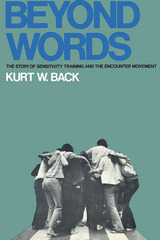
Beyond Words
Story of Sensitivity Training and the Encounter Movement
Kurt W. Back
Russell Sage Foundation, 1972
Sensitivity training, T-Groups, and encounter groups have become a way of life. Beyond Words traces the history of this movement, the background of its successes, its varieties, and its failures. Dr. Back's approach is neither one of wide-eyed admiration nor hostility. Instead, he has written a book that provides the first long, hard look at sensitivity training as a social phenomenon. From its fortuitous beginnings the movement is followed through its developments at Bethel, its growth across the country, its new centers in California, its spread to Europe. The novelty of this movement, an almost religious exercise based on the scientific ethos, is related to the peculiar conditions of the last quarter century. The movement has acquired its own mythos. Dr. Back examines the interplay of the conflicting aims of self-expression and change, and shows how these contradictory aims have affected the ramifications of the movement in theory, in management, in recreation, and in education. Results emerging from studies on effects of sensitivity training indicate a recurrent pattern of great immediate emphasis followed by little permanent beneficial effect. Finally, Beyond Words assesses the overall impact of the movement, its relation to science, its possible changes, and its portent as a symptom of the state of society. Dr. Back examines the interplay of the conflicting aims of self-expression and change, and shows how these contradictory aims have affected the ramifications of the movement in theory, in management, in recreation, and in education.
[more]
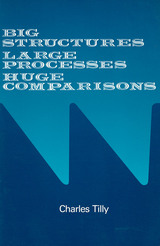
Big Structures, Large Processes, Huge Comparisons
Charles Tilly
Russell Sage Foundation, 1984
This bold and lively essay is one of those rarest of intellectual achievements, a big small book. In its short length are condensed enormous erudition and impressive analytical scope. With verve and self-assurance, it addresses a broad, central question: How can we improve our understanding of the large-scale processes and structures that transformed the world of the nineteenth century and are transforming our world today? Tilly contends that twentieth-century social theories have been encumbered by a nineteenth century heritage of "pernicious postulates." He subjects each misleading belief to rigorous criticism, challenging many standard social science paradigms and methodologies. As an alternative to those timeless, placeless models of social change and organization, Tilly argues convincingly for a program of concrete, historically grounded analysis and systematic comparison. To illustrate the strategies available for such research, Tilly assesses the works of several major practitioners of comparative historical analysis, making skillful use of this selective review to offer his own speculative, often unconventional accounts of our recent past. Historically oriented social scientists will welcome this provocative essay and its wide-ranging agenda for comparative historical research. Other social scientists, their graduate and undergraduate students, and even the interested general reader will find this new work by a major scholar stimulating and eminently readable. This is the second of five volumes commissioned by the Russell Sage Foundation to mark its seventy-fifth anniversary. "In this short, brilliant book Tilly suggests a way to think about theories of historical social change....This book should find attentive readers both in undergraduate courses and in graduate seminars. It should also find appreciative readers, for Tilly is a writer as well as a scholar." —Choice
[more]
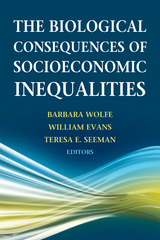
The Biological Consequences of Socioeconomic Inequalities
Barbara Wolfe
Russell Sage Foundation, 2013
Social scientists have repeatedly uncovered a disturbing feature of economic inequality: people with larger incomes and better education tend to lead longer, healthier lives. This pattern holds across all ages and for virtually all measures of health, apparently indicating a biological dimension of inequality. But scholars have only begun to understand the complex mechanisms that drive this disparity. How exactly do financial well-being and human physiology interact? The Biological Consequences of Socioeconomic Inequalities incorporates insights from the social and biological sciences to quantify the biology of disadvantage and to assess how poverty gets under the skin to impact health. Drawing from unusually rich datasets of biomarkers, brain scans, and socioeconomic measures, Biological Consequences of Socioeconomic Inequalities illustrates exciting new paths to understanding social inequalities in health. Barbara Wolfe, William N. Evans and Nancy Adler begin the volume with a critical evaluation of the literature on income and health, providing a lucid review of the difficulties of establishing clear causal pathways between the two variables. In their chapter, Arun S. Karlamangla, Tara L. Gruenewald, and Teresa E. Seeman outline the potential of biomarkers—such as cholesterol, heart pressure, and C-reactive protein—to assess and indicate the factors underlying health. Edith Chen, Hannah M. C. Schreier, and Meanne Chan reveal the empirical power of biomarkers by examining asthma, a condition steeply correlated with socioeconomic status. Their analysis shows how stress at the individual, family, and neighborhood levels can increase the incidence of asthma. The volume then turns to cognitive neuroscience, using biomarkers in a new way to examine the impact of poverty on brain development. Jamie Hanson, Nicole Hair, Amitabh Chandra, Ed Moss, Jay Bhattacharya, Seth D. Pollack, and Barbara Wolfe use a longitudinal Magnetic Resonance Imaging (MRI) study of children between the ages of four and eighteen to study the link between poverty and limited cognition among children. Michelle C. Carlson, Christopher L. Seplaki, and Teresa E. Seeman also focus on brain development to examine the role of socioeconomic status in cognitive decline among older adults. Featuring insights from the biological and social sciences, Biological Consequences of Socioeconomic Inequalities will be an essential resource for scholars interested in socioeconomic disparities and the biological imprint that material deprivation leaves on the human body.
[more]
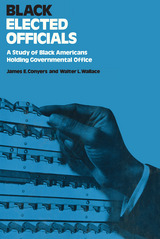
Black Elected Officials
Study of Black Americans Holding Government Office
James Conyers
Russell Sage Foundation, 1976
Presents the first nationwide profile of black Americans (over 3,500) who now hold elective governmental office. The book is based upon a questionnaire survey of black elected officials together with a comparison survey of white men and women elected to similar types of offices in the same geographical region. The inclusion of extensive quotations from interviews with thirty-four black elected officials adds realism, depth, and insight to the quantitative analysis. The authors interrelate fresh and meaningful information on the political ideologies and motivations of black officials, their perceived political impacts, and expectations for the future. Presents the first nationwide profile of black Americans (over 3,500) who now hold elective governmental office. The book is based upon a questionnaire survey of black elected officials together with a comparison survey of white men and women elected to similar types of offices in the same geographical region. The inclusion of extensive quotations from interviews with thirty-four black elected officials adds realism, depth, and insight to the quantitative analysis. The authors interrelate fresh and meaningful information on the political ideologies and motivations of black officials, their perceived political impacts, and expectations for the future.
[more]
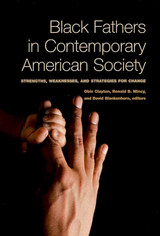
Black Fathers in Contemporary American Society
Strengths, Weaknesses, and Strategies for Change
Obie Clayton
Russell Sage Foundation, 2003
The majority of African American children live in homes without their fathers, but the proportion of African American children living in intact, two-parent families has risen significantly since 1995. Black Fathers in Contemporary American Society looks at father absence from two sides, offering an in-depth analysis of how the absence of African American fathers affects their children, their relationships, and society as a whole, while countering the notion that father absence and family fragmentation within the African American community is inevitable. Editors Obie Clayton, Ronald B. Mincy, and David Blankenhorn lead a diverse group of contributors encompassing a range of disciplines and ideological perspectives who all agree that father absence among black families is one of the most pressing social problems today. In part I, the contributors offer possible explanations for the decline in marriage among African American families. William Julius Wilson believes that many men who live in the inner city no longer consider marriage an option because their limited economic prospects do not enable them to provide for a family. Part II considers marriage from an economic perspective, emphasizing that it is in part a wealth-producing institution. Maggie Gallagher points out that married people earn, invest, and save more than single people, and that when marriage rates are low in a community, it is the children who suffer most. In part III, the contributors discuss policies to reduce absentee fatherhood. Wornie Reed demonstrates how public health interventions, such as personal development workshops and work-related skill-building services, can be used to address the causes of fatherlessness. Wade Horn illustrates the positive results achieved by fatherhood programs, especially when held early in a man's life. In the last chapter, Enola Aird notes that from 1995 to 2000, the proportion of African American children living in two-parent, married couple homes rose from 34.8 to 38.9 percent; a significant increase indicating the possible reversal of the long-term shift toward black family fragmentation. Black Fathers in Contemporary American Society provides an in-depth look at a problem affecting millions of children while offering proof that the trend of father absence is not irrevocable.
[more]
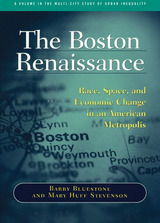
The Boston Renaissance
Race, Space, and Economic Change in an American Metropolis
Barry Bluestone
Russell Sage Foundation, 2000
This volume documents metropolitan Boston's metamorphosis from a casualty of manufacturing decline in the 1970s to a paragon of the high-tech and service industries in the 1990s. The city's rebound has been part of a wider regional renaissance, as new commercial centers have sprung up outside the city limits. A stream of immigrants have flowed into the area, redrawing the map of ethnic relations in the city. While Boston's vaunted mind-based economy rewards the highly educated, many unskilled workers have also found opportunities servicing the city's growing health and education industries. Boston's renaissance remains uneven, and the authors identify a variety of handicaps (low education, unstable employment, single parenthood) that still hold minorities back. Nonetheless this book presents Boston as a hopeful example of how America's older cities can reinvent themselves in the wake of suburbanization and deindustrialization. A Volume in the Multi-City Study of Urban Inequality
[more]
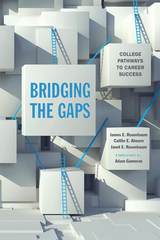
Bridging the Gaps
College Pathways to Career Success
James E. Rosenbaum
Russell Sage Foundation, 2017
College-for-all has become the new American dream. Most high school students today express a desire to attend college, and 90% of on-time high school graduates enroll in higher education in the eight years following high school. Yet, degree completion rates remain low for non-traditional students—students who are older, low-income, or have poor academic achievement—even at community colleges that endeavor to serve them. What can colleges do to reduce dropouts? In Bridging the Gaps, education scholars James Rosenbaum, Caitlin Ahearn, and Janet Rosenbaum argue that when institutions focus only on bachelor’s degrees and traditional college procedures, they ignore other pathways to educational and career success. Using multiple longitudinal studies, the authors evaluate the shortcomings and successes of community colleges and investigate how these institutions can promote alternatives to BAs and traditional college procedures to increase graduation rates and improve job payoffs.
The authors find that sub-baccalaureate credentials—associate degrees and college certificates—can improve employment outcomes. Young adults who complete these credentials have higher employment rates, earnings, autonomy, career opportunities, and job satisfaction than those who enroll but do not complete credentials. Sub-BA credentials can be completed at community college in less time than bachelor’s degrees, making them an affordable option for many low-income students.
Bridging the Gaps shows that when community colleges overemphasize bachelor’s degrees, they tend to funnel resources into remedial programs, and try to get low-performing students on track for a BA. Yet, remedial programs have inconsistent success rates and can create unrealistic expectations, leading struggling students to drop out before completing any degree. The authors show that colleges can devise procedures that reduce remedial placements and help students discover unseen abilities, attain valued credentials, get good jobs, and progress on degree ladders to higher credentials.
To turn college-for-all into a reality, community college students must be aware of their multiple credential and career options. Bridging the Gaps shows how colleges can create new pathways for non-traditional students to achieve success in their schooling and careers.
The authors find that sub-baccalaureate credentials—associate degrees and college certificates—can improve employment outcomes. Young adults who complete these credentials have higher employment rates, earnings, autonomy, career opportunities, and job satisfaction than those who enroll but do not complete credentials. Sub-BA credentials can be completed at community college in less time than bachelor’s degrees, making them an affordable option for many low-income students.
Bridging the Gaps shows that when community colleges overemphasize bachelor’s degrees, they tend to funnel resources into remedial programs, and try to get low-performing students on track for a BA. Yet, remedial programs have inconsistent success rates and can create unrealistic expectations, leading struggling students to drop out before completing any degree. The authors show that colleges can devise procedures that reduce remedial placements and help students discover unseen abilities, attain valued credentials, get good jobs, and progress on degree ladders to higher credentials.
To turn college-for-all into a reality, community college students must be aware of their multiple credential and career options. Bridging the Gaps shows how colleges can create new pathways for non-traditional students to achieve success in their schooling and careers.
[more]
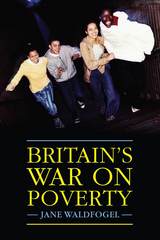
Britain's War on Poverty
Jane Waldfogel
Russell Sage Foundation, 2010
In 1999, one in four British children lived in poverty—the third highest child poverty rate among industrialized countries. Five years later, the child poverty rate in Britain had fallen by more than half in absolute terms. How did the British government accomplish this and what can the United States learn from the British experience? Jane Waldfogel offers a sharp analysis of the New Labour government's anti-poverty agenda, its dramatic early success and eventual stalled progress. Comparing Britain's anti-poverty initiative to U.S. welfare reform, the book shows how the policies of both countries have affected child poverty, living standards, and well-being in low-income families and suggests next steps for future reforms. Britain's War on Poverty evaluates the three-pronged anti-poverty strategy employed by the British government and what these efforts accomplished. British reforms sought to promote work and make work pay, to increase financial support for families with children, and to invest in the health, early-life development, and education of children. The latter two features set the British reforms apart from the work-oriented U.S. welfare reforms, which did not specifically target income or program supports for children. Plagued by premature initiatives and what some experts called an overly ambitious agenda, the British reforms fell short of their intended goal but nevertheless significantly increased single-parent employment, raised incomes for low-income families, and improved child outcomes. Poverty has fallen, and the pattern of low-income family expenditures on child enrichment and healthy food has begun to converge with higher-income families. As Waldfogel sees it, further success in reducing child poverty in Britain will rely on understanding who is poor and who is at highest risk. More than half of poor children live in families where at least one parent is working, followed by unemployed single- and two-parent homes, respectively. Poverty rates are also notably higher for children with disabled parents, large families, and for Pakistani and Bangladeshi children. Based on these demographics, Waldfogel argues that future reforms must, among other goals, raise working-family incomes, provide more work for single parents, and better engage high-risk racial and ethnic minority groups. What can the United States learn from the British example? Britain's War on Poverty is a primer in the triumphs and pitfalls of protracted policy. Notable differences distinguish the British and U.S. models, but Waldfogel asserts that a future U.S. poverty agenda must specifically address child poverty and the income inequality that helps create it. By any measurement and despite obstacles, Britain has significantly reduced child poverty. The book's key lesson is that it can be done.
[more]
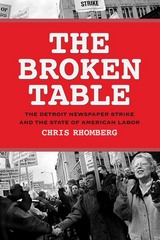
The Broken Table
The Detroit Newspaper Strike and the State of American Labor
Chris Rhomberg
Russell Sage Foundation, 2012
When the Detroit newspaper strike was settled in December 2000, it marked the end of five years of bitter and violent dispute. No fewer than six local unions, representing 2,500 employees, struck against the Detroit News, the Detroit Free Press, and their corporate owners, charging unfair labor practices. The newspapers hired permanent replacement workers and paid millions of dollars for private security and police enforcement; the unions and their supporters took their struggle to the streets by organizing a widespread circulation and advertising boycott, conducting civil disobedience, and publishing a weekly strike newspaper. In the end, unions were forced to settle contracts on management's terms, and fired strikers received no amnesty. In The Broken Table, Chris Rhomberg sees the Detroit newspaper strike as a historic collision of two opposing forces: a system in place since the New Deal governing disputes between labor and management, and decades of increasingly aggressive corporate efforts to eliminate unions. As a consequence, one of the fundamental institutions of American labor relations—the negotiation table—has been broken, Rhomberg argues, leaving the future of the collective bargaining relationship and democratic workplace governance in question. The Broken Table uses interview and archival research to explore the historical trajectory of this breakdown, its effect on workers' economic outlook, and the possibility of restoring democratic governance to the business-labor relationship. Emerging from the New Deal, the 1935 National Labor Relations Act protected the practice of collective bargaining and workers' rights to negotiate the terms and conditions of their employment by legally recognizing union representation. This system became central to the democratic workplace, where workers and management were collective stakeholders. But efforts to erode the legal protections of the NLRA began immediately, leading to a parallel track of anti-unionism that began to gain ascendancy in the 1980s. The Broken Table shows how the tension created by these two opposing forces came to a head after a series of key labor disputes over the preceding decades culminated in the Detroit newspaper strike. Detroit union leadership charged management with unfair labor practices after employers had unilaterally limited the unions' ability to bargain over compensation and work conditions. Rhomberg argues that, in the face of management claims of absolute authority, the strike was an attempt by unions to defend workers' rights and the institution of collective bargaining, and to stem the rising tide of post-1980s anti-unionism. In an era when the incidence of strikes in the United States has been drastically reduced, the 1995 Detroit newspaper strike stands out as one of the largest and longest work stoppages in the past two decades. A riveting read full of sharp analysis, The Broken Table revisits the Detroit case in order to show the ways this strike signaled the new terrain in labor-management conflict. The book raises broader questions of workplace governance and accountability that affect us all.
[more]
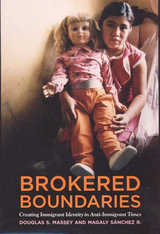
Brokered Boundaries
Immigrant Identity in Anti-Immigrant Times
Douglas S. Massey
Russell Sage Foundation, 2010
Anti-immigrant sentiment reached a fever pitch after 9/11, but its origins go back much further. Public rhetoric aimed at exposing a so-called invasion of Latino immigrants has been gaining ground for more than three decades—and fueling increasingly restrictive federal immigration policy. Accompanied by a flagging U.S. economy—record-level joblessness, bankruptcy, and income inequality—as well as waning consumer confidence, these conditions signaled one of the most hostile environments for immigrants in recent memory. In Brokered Boundaries, Douglas Massey and Magaly Sánchez untangle the complex political, social, and economic conditions underlying the rise of xenophobia in U.S. society. The book draws on in-depth interviews with Latin American immigrants in metropolitan New York and Philadelphia and—in their own words and images—reveals what life is like for immigrants attempting to integrate in anti-immigrant times. What do the social categories "Latino" and "American" actually mean to today's immigrants? Brokered Boundaries analyzes how first- and second-generation immigrants from Central and South America and the Caribbean navigate these categories and their associated meanings as they make their way through U.S. society. Massey and Sánchez argue that the mythos of immigration, in which newcomers gradually shed their respective languages, beliefs, and cultural practices in favor of a distinctly American way of life, is, in reality, a process of negotiation between new arrivals and native-born citizens. Natives control interactions with outsiders by creating institutional, social, psychological, and spatial mechanisms that delimit immigrants' access to material resources and even social status. Immigrants construct identities based on how they perceive and respond to these social boundaries. The authors make clear that today's Latino immigrants are brokering boundaries in the context of unprecedented economic uncertainty, repressive anti-immigrant legislation, and a heightening fear that upward mobility for immigrants translates into downward mobility for the native-born. Despite an absolute decline in Latino immigration, immigration-related statutes have tripled in recent years, including many that further shred the safety net for legal permanent residents as well as the undocumented. Brokered Boundaries shows that, although Latin American immigrants come from many different countries, their common reception in a hostile social environment produces an emergent Latino identity soon after arrival. During anti-immigrant times, however, the longer immigrants stay in America, the more likely they are to experience discrimination and the less likely they are to identify as Americans.
[more]
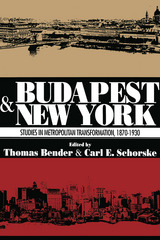
Budapest and New York
Studies in Metropolitan Transformation, 1870-1930
Thomas Bender
Russell Sage Foundation, 1994
Little over a century ago, New York and Budapest were both flourishing cities engaging in spectacular modernization. By 1930, New York had emerged as an innovating cosmopolitan metropolis, while Budapest languished under the conditions that would foster fascism. Budapest and New York explores the increasingly divergent trajectories of these once-similar cities through the perspectives of both Hungarian and American experts in the fields of political, cultural, social and art history. Their original essays illuminate key aspects of urban life that most reveal the turn-of-the-century evolution of New York and Budapest: democratic participation, use of public space, neighborhood ethnicity, and culture high and low. What comes across most strikingly in these essays is New York's cultivation of social and political pluralism, a trend not found in Budapest. Nationalist ideology exerted tremendous pressure on Budapest's ethnic groups to assimilate to a single Hungarian language and culture. In contrast, New York's ethnic diversity was transmitted through a mass culture that celebrated ethnicity while muting distinct ethnic traditions, making them accessible to a national audience. While Budapest succumbed to the patriotic imperatives of a nation threatened by war, revolution, and fascism, New York, free from such pressures, embraced the variety of its people and transformed its urban ethos into a paradigm for America. Budapest and New York is the lively story of the making of metropolitan culture in Europe and America, and of the influential relationship between city and nation. In unifying essays, the editors observe comparisons not only between the cities, but in the scholarly outlooks and methodologies of Hungarian and American histories. This volume is a unique urban history. Begun under the unfavorable conditions of a divided world, it represents a breakthrough in cross-cultural, transnational, and interdisciplinary historical work.
[more]
READERS
Browse our collection.
PUBLISHERS
See BiblioVault's publisher services.
STUDENT SERVICES
Files for college accessibility offices.
UChicago Accessibility Resources
home | accessibility | search | about | contact us
BiblioVault ® 2001 - 2024
The University of Chicago Press









